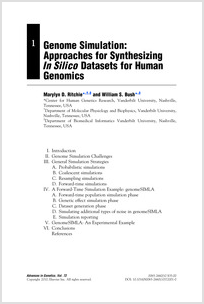Ritchie MD, Bush WS,.
Simulated data is a necessary first step in the evaluation of new analytic methods because in simulated data the true effects are known. To successfully develop novel statistical and computational methods for genetic analysis, it is vital to simulate datasets consisting of single nucleotide polymorphisms (SNPs) spread throughout the genome at a density similar to that observed by new high-throughput molecular genomics studies. In addition, the simulation of environmental data and effects will be essential to properly formulate risk models for complex disorders. Data simulations are often criticized because they are much less noisy than natural biological data, as it is nearly impossible to simulate the multitude of possible sources of natural and experimental variability. However, simulating data in silico is the most straightforward way to test the true potential of new methods during development. Thus, advances that increase the complexity of data simulations will permit investigators to better assess new analytical methods. In this work, we will briefly describe some of the current approaches for the simulation of human genomics data describing the advantages and disadvantages of the various approaches. We will also include details on software packages available for data simulation. Finally, we will expand upon one particular approach for the creation of complex, human genomic datasets that uses a forward-time population simulation algorithm: genomeSIMLA. Many of the hallmark features of biological datasets can be synthesized in silico; still much research is needed to enhance our capabilities to create datasets that capture the natural complexity of biological datasets.

